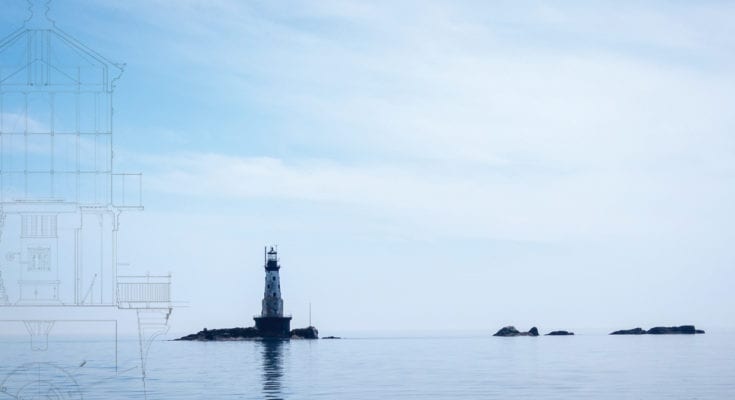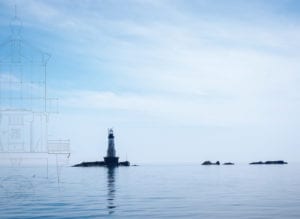This post was originally published on this site
A Volunteer Movement to Save a Lighthouse
Maybe it’s the isolation, the endless battle against wind and waves, or the tales sheltered within. Whatever the allure, I’m drawn to lighthouses. And I have a favorite.
Rock of Ages Lighthouse stands isolated, 5 miles from the southern harbor of Isle Royale National Park.
The last time I saw it years ago, it had been abandoned to the past, its solitary 130-foot, white tower atop a fortress of black iron, battered and resolute, stationed on an unforgiving spit of the ancient Rock of Ages geological ridge that rises from the Lake floor.
I’d never stopped wondering if anything would ever be done to protect that distinctive lighthouse. Then this past October, a young 30s-something couple moved into my neighborhood south of Duluth.
As we sat at my kitchen table and I chattered on about kayaking and my love for Lake Superior, they quietly handed me a brochure with Rock of Ages on its cover.
David Gerth, a reserved fellow, founded the Rock of Ages Lighthouse Preservation Society in 2008 and now serves as its board president and executive director. His wife, Heather, who has a smile that outshines any lighthouse lens, came on board in 2016 and serves as assistant director.
“How can I get to the lighthouse?” I eagerly asked after learning of their passion for my light.
Heather, who knows how to set a hook, told me that for now, the only way to get to The Rock is to volunteer.
The non-profit preservation society has a three-part mission: to preserve and restore the lighthouse; to safeguard its building, artifacts and records; and to educate and inform the public so that its history may be accurately interpreted and preserved. This history of The Rock certainly deserves saving.
Lake Superior is notorious for swallowing ships in stormy 35-foot seas, but the Rock of Ages reef has even sunk ships in clear weather and fog-shrouded dead calm. It’s hard to comprehend how badly this lighthouse was needed until you stand in its tower to see the reef extending far outward, menacingly just below the water’s surface. Crews navigating these waters well understood its treachery, even after the lighthouse beacon was lit.
Records show the reef claimed three ships from 1877 to 1933: A 200-foot passenger vessel Cumberland (1877), a 265-foot steamer Henry Chisholm (1898) and a 259-foot luxury vessel George M. Cox (1933). The Cumberland and Chisholm lie on top of each other a short distance from the light station. The ragged basalt ridge on which the lighthouse rests rises 15 feet out of the water, is 100 yards long and a mere 20 yards wide.
The lighthouse is an amazingly well-built structure that has withstood the ravages of Lake Superior for more than a century. Quarrymen blasted out a 60-foot-wide section of the ridge to construct the 30-foot high caisson (the structure’s black base) that supports 10 stories of working and living space, including the lens room. The caisson was constructed of poured concrete walls, 12 feet thick, encased in iron plating. The sheer mass of the iron, concrete and brick structure anchors it solidly to the exposed rock.
The lighthouse was completed in 1908, and the second order Fresnel lens was lit September 15, 1910, shining 19 miles across the Lake.
It operated as a stag lighthouse (men only; no families) until 1978 when the lighthouse was automated and the Coast Guard withdrew the last keeper. In 1985, the Fresnel lens was retired to the Windigo Ranger Station and replaced with a solar-powered optic still useful to boats of all sizes.
The lighthouse, though, was left pretty much to its own defenses, being eroded by the Lake and by time.
In 2013, the lighthouse was transferred from the U.S. Coast Guard to Isle Royale National Park. The National Park Service and the preservation society maintain a partnership agreement to restore, maintain and, eventually, to operate Rock of Ages. The goal is to welcome visitors to celebrate the 110th anniversary of its first lighting in 2020.
The society is committed to creating a living historical site. When it opens to the public, plans have visitors arriving at the dock as if they were reporting for duty as lighthouse keepers in 1933. Future use of the lighthouse will be included in the park’s upcoming cultural resources plan.
As important as the structure are the stories. Without an understanding of the incredible feat of the construction of the lighthouse and the tales of its keepers, the lighthouse would just be an empty building.
Key to the Gerths’ vision is “friendraising,” building a supportive base through membership and volunteers of all ages to sustain The Rock for generations.
What’s unique about this preservation project, beyond the rugged location of the lighthouse, is David Gerth. What would motivate a young man to tackle the monumental project of preserving a remote lighthouse from a bygone era?
For one thing, like The Rock, David appreciates solitude. He spent part of his youth in the tiny village of Finland, Minnesota, enjoying numerous solo backpacking trips to the Boundary Waters Wilderness Canoe Area Wilderness.
In his late 20s, he decided he wanted to preserve a lighthouse, but why this one?
“It was the remoteness. I like adventure stories like that of Shackleton, people who go off onto the edge fascinate me. At Rock of Ages and Isle Royale, you can take a week and do that. No RVs, cars, radios, TVs, lights and, up until very recently, no cell phone. You are just out there alone. Also, this lighthouse is in good condition and its close proximity to the National Park means it could be accessible to the public, so it could be shared.”
On his first trip to Isle Royale, David outlined his Rock of Ages preservation scheme to park staff at Isle Royale’s Windigo Ranger Station. Of all the thousands of visitors to the park with money, time, resources and years behind them, none had ever expressed interest in the Rock of Ages restoration, they told him.
David, his twin brother, Chuck, and brother Nathan, learned from their parents that dreams come alive when you volunteer to share your talents, expertise and passion. The brothers enthusiastically joined David and brought helpful skills. David is a building facility manager for the Duluth Public School District. Chuck, educated in industrial technology, is an engineer with Amstel Steel in Missouri, and Nathan is a digital archivist at the University of Nevada, Reno. All three still consider themselves North Shore boys. Heather is an environmental educator with a background in non-profit organizing.
When Heather and David met, he told her he was into a “lighthouse thing.”
Heather says she thought, “OK, I’m dedicated to birding and my job, so I’ll have a partner who will understand what it means to be passionate.”
They got engaged on Isle Royale in 2015, but David wasn’t able to take Heather to the lighthouse until 2016, when, on their honeymoon, he brought her to meet his other love.
Heather, not the jealous type, had agreed to support the restoration. She started rethinking her decision as soon as she entered the engine room and began ascending the stairs, piled with debris. Her resolve further deteriorated seeing the mess on the sixth-floor watch room.
“What have I gotten myself into?” she thought.
David quietly said, “Keep walking upstairs, Heather.” They climbed to tower’s lens room, 117 feet above the Lake.
David opened the door to the catwalk; swallows swirled around them. Wave upon glorious wave of emerald green water rolled over the Rock of Ages reef stretching below them for miles.
The effect on Heather? Well, let’s just say, she’s not the only one in this marriage who knows how to set a hook.
After I became a member last October, I wanted to help the society in whatever way I could, but I haven’t yet been able to visit the lighthouse.
There are no age restrictions for those who volunteer, but some of the work at the lighthouse involves walking up and down 10 flights of winding stairs several times a day, carrying 25 pounds of materials, removing and repairing failed plaster walls, painting walls, ceilings and stairs, installing reproduction windows, removing and installing floors, wood door trim work, baseboards. Each year one or two rooms are being restored; this year they will be restoring the third-floor kitchen.
For those who volunteer at Barnum Island, just off Isle Royale and where the volunteers are housed, the work may be a little less difficult, but be prepared to put in full days. You might be painting historic cabins, boathouses and fish houses, or roofing, glazing windows and doing general cleaning and maintenance.
This year, while I can’t carry a heavy load, I can carry a story, so gathering oral and recorded history will be my contribution. I’ve interviewed some former keepers (see the side stories). Similarly, others can do historic research, write grants, create reproduction furniture or help with marketing and fundraising.
Structurally, the lighthouse is in great condition. The National Park Service will assist with in-kind help on any outside restoration that would be too specialized for volunteers. The NPS also will most likely help to restore the concrete pier that is badly damaged.
But the rest, including functional systems, is the responsibility of the preservation society through its membership, donations and fundraising efforts.
Volunteers like to know that their hard work becomes part of the lighthouse history and at Barnum Island there is a large, leather-bound log book where they record their experiences. Surprisingly, their entries often parallel those of former keepers – the simple hearty meals, the challenges of weather, of living in close quarters, of no access to technology or modern amenities and what it’s like to live in a pristine wilderness on a remote island.
Volunteers span all ages and skills. Preservation society members get to apply first for volunteering at Isle Royale, with summer applications available in April. The spots fill quickly for the four- to five-member crews working each week for six weeks. Rock of Ages Lighthouse Preservation Society has about 75 members.
I queried David about how he, the man who once sought solitude, enjoys spending his summers surrounded by crews of people looking to him for leadership. He beams me a gentle smile and says, “The most successful trips are when we have folks from all ages, everyone is learning from each other, and we’re getting people out there enjoying what we have found.”
When you meet David – maybe as a volunteer or in 2020 when Rock of Ages opens to the public – you’ll see that he couldn’t be happier, sharing what he’s found and letting the light shine for the rest of us.
TALES OF TWO KEEPERS
In my capacity as a Rock of Ages Preservation Society volunteer, I have been gathering stories from those connected to the lighthouse. Here are two from my interviews.
Ron Gaspar of Omaha had dreamed of serving his country in the U.S. Coast Guard since he was a young lad. After completing boot camp in 1953, he was dropped off in a blizzard in Grand Marais, Minnesota, and later transported to Rock of Ages, where he served 1954 to 1955.
His wife, Joanne, lived at the Coast Guard housing in Grand Marais, seeing Ron every 45 days during his two-week leaves. Five men were stationed at The Rock, and their only transportation was a 25-foot “wickie” lighthouse boat (the nickname for lighthouse nerds harkening to a lamp wick).
One frigid September night, dressed in heavy gear, Ron went out on the concrete dock to throw garbage out while the other men sat inside playing cards.
Suddenly, a huge wave swept Ron into Lake Superior and a current swiftly dragged him out to sea. No one heard his screams. As he desperately swam toward The Rock, his mind replayed the old saying: “Superior won’t give up her dead.”
Determined that the Lake couldn’t have him, he swam diagonally to the current, grabbed the rubber tires lining the dock and heaved himself out. Shaken and dripping wet, he tromped inside and told the other guardsmen that he’d just nearly lost his life. They looked up from their game. All they said was, “Oh!”
Mark Bauer grew up on a Wisconsin dairy farm and joined the U.S. Coast Guard in 1967.
In 1973, his superiors informed him that he’d be relieving a man who’d had a breakdown, suffering from the isolation at a desolate lighthouse on Lake Superior. So at 3 a.m. in complete darkness, Mark was rushed to be officer in charge at Rock of Ages. He had no idea of the landscape until the next morning. What he saw didn’t faze him. “I revel in solitude and love being alone with Mother Nature in all her splendor.” He’d later stand along the sand bars on the inland lakes of Isle Royale and think, “I get paid to be here?”
Mark became acquainted with the resident spirit at The Rock. He and the other men would hear footsteps coming up the heavy, winding metal stairs only to find no one there, but their puppy, Rocky, would begin to growl.
One night, Mark had the 2 a.m. watchroom duty. Every 15 minutes, he was to radio to Duluth. Reading a book in an easy chair with his feet resting on another ladder-back chair, he dozed off. He awoke with a start when his feet fell off the chair – luckily for him because 15 minutes had passed and he needed to call Duluth. Back from the radio room, he started to read again in the same position, once again dozing. Sure enough, 15 minutes later he felt his feet “fall” off the chair. Once again, after the call, he took up his book and his position. This time he closed his eyes, but did not doze off. Fifteen minutes passed and, boom, he felt his feet knocked off the chair – a definite call to duty.
The other men also knew of the spirit keeper, who seemed intent on making sure there were no slackers at The Rock. They believe it to be the ghost of a worker, knocked off a crane into the Lake at the time the lighthouse was being built. He was never found, but Mark is sure the benign spirit took up residence and kept the keepers on their toes.
Freelance writer Deborah Mann retired in 2016 from her job as student leadership facilitator and communications manager at Cornell University in New York. She and her husband, John, an artist, spent a year in the Keweenaw Peninsula before settling near Duluth and have circled the Lake many times by car, camping or staying in hotels.
Continue to read this article in Lake Superior Magazine.


